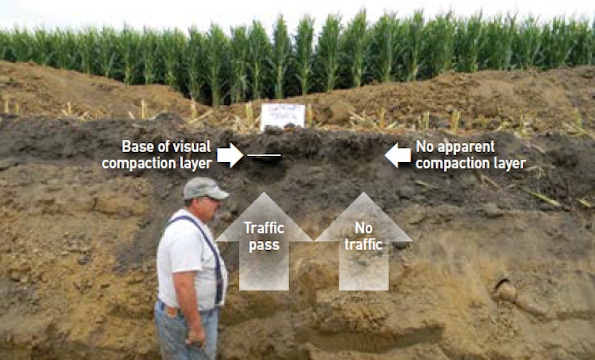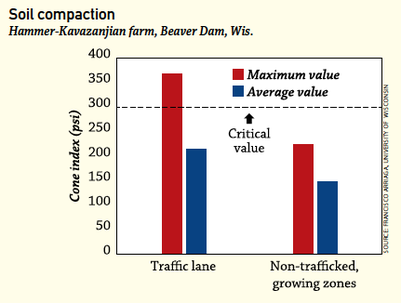
Think different Wisconsin farmer Charlie Hammer has standardized row widths to multiples of 24 on all equipment except his 12-row combine. The corn head is half the width of the planter, so it runs on the traffic lanes half of the time. Overall, this amounts to driving on 25% of his ground, compared to conventional farms where wheels drive on more than 50% to 70% of fields.
January 8, 2016

Charlie Hammer has never done the same thing for too long, except when it comes to wheels on soil. He has deliberately traveled the same controlled-traffic (CT) lanes on his Beaver Dam, Wis., farm to limit soil compaction.
He and wife Nancy Kavazanjian are recognized for new ideas, especially to build soil health and farm productivity. “Our soil, our strength” is their Century farm’s motto. (Nancy is also a United Soybean United Soybean Board director, and Chairwoman, U.S. Farmers and Ranchers Association.)
“We did not set out to design a controlled-traffic system, but it evolved from strip-tilling continuous corn,” Hammer says. “We were routinely moving 15 inches to one side or another of last year’s rows, and guidance made it easy to standardize traffic paths. I’m real happy with where we’re at. Now we have to perfect it.”
New SMS software enhances his A-B (navigation) reference lines for easy field access.
“Any time you change anything, it requires more management initially, compared to just sending someone out to drive in circles until they finish 100 acres,” Hammer jokes. “You have to know that there’s a big learning curve with any new practice, plus yield tradeoffs. But the reward for 10 years [of controlled traffic] has been the motivation to eventually extend the practice to most of our ground over time.”
Soil pit proof
A pipeline trench dug perpendicular to field traffic created a handy controlled-traffic test plot. The 4-foot soil pit revealed intentionally compacted traffic lanes next to uncompacted growing zones. Soil penetrometer readings by Francisco Arriaga, a soil scientist at the University of Wisconsin, confirmed that the controlled traffic lanes comprise 25% of the farm’s ground (trafficking six rows out of 24 in controlled-traffic fields), compared to over 50% to 70% of fields commonly driven on in conventional farm settings.
“Also, these estimates only take into account planting and harvest equipment, and not other equipment passes in the field, so percentages can actually be greater,” Arriaga says.
“It was easy to see surface compaction extending 8 to 9 inches deep beneath the traffic lanes,” Hammer says. “The rest of the field had no compaction problems; just what you would expect.”
He credits Illinois no-till farmer Jim Kinsella (bit.ly/CSDKinsella) for early inspiration on building soil health, trying strip-till and fertilizing by soil zone.
Multiples of 24
After 10 years of controlled traffic, Hammer’s standardized row widths to multiples of 24 on all equipment except the 12-row combine. That includes a planter, sidedress and strip-till units and sprayer. The combine operates on its own controlled-traffic track, with one side traveling in the lane made by other equipment.
Unlike some controlled-traffic practitioners, he has not had rutting issues from the traffic lanes, perhaps because of their high-residue environment; their 200-acre controlled-traffic field has been no-tilled or strip-tilled for 28 years.
“Raising continuous corn at populations of 38,000 to 42,000 seeds per acre plus cover crops over the years has built our soil structure,” Hammer says. “That said, you do see a depression in the traffic lanes. We can’t foresee a rutting problem, though.”
Rutted lanes can be easily refilled with a tillage tool designed mainly for use with pivot irrigation tires, says Randall Reeder, ag engineer emeritus, Ohio State University Extension.
CT through the year
Hammer builds his strips in the fall, weather and workload permitting, and freshen them in the spring. Their tractor is equipped with 24-inch tracks and saddle tanks for in-furrow fertilization and insecticide, and he adds a 60-foot toolbar with coulter injection for split-row nitrogen application. He follows planting with broadcast weed and feed and, “when things go smoothly,” he uses split-row coulter injection to sidedress about 35% to 40% of the season’s N mid season. The past two years, he’s built strips in the spring. He varies his seeding rate by management zone.
Benefits of controlled traffic
The red bars show higher compaction in Charlie Hammer’s traffic lanes compared to the “growing zones.” The dashed line is the critical 300-psi level, above which soil compaction usually restricts crop root growth. The soil density in their growing zones was ideal for root growth.

“The traffic-lane cone index ranged up to 369 psi,” says University of Wisconsin soil scientist Francisco Arriaga, who measured with a penetrometer.
One equipment field pass can create about 70% of total soil compaction if conditions are right, he says.
Controlled traffic benefits
Reduced soil compaction increases crop yields by creating traffic zones and growing zones.
Better traction and drainage. The traffic lanes retain less moisture and have earlier and better traction earlier in wet springs (read a profile of another farm using controlled traffic successfully).
10%+ fuel savings, based on less rolling resistance from tramline-compacted soils. British farm trials in 2009 found 10% less fuel used and 11% reduced time spent on field operations.
Yield gains of 5% to 15% in corn, soybean and wheat is realistic, as well as more profitable.
Increased soil biologic activity and productivity.
More even emergence.
Improved soil water absorption and storage from preserving soil pore space.
Compacting soil can cut crop yields by as much as 50% because of reduced soil pore space, higher root-penetration resistance and improved plant nutrient availability, according to University of Wisconsin research.
Less driver fatigue, input, overlap and waste.
-- Tim Chamen et al., CTF Europe Ltd, Graham Adsit, Long Winter Farm, University of Wisconsin Extension Agronomist emeritus Dick Wolkowski
About the Author(s)
You May Also Like



